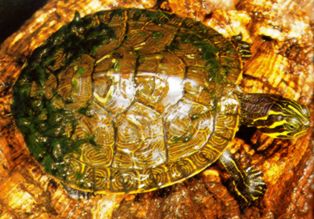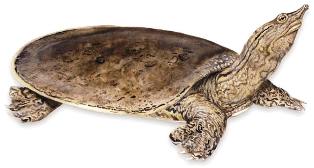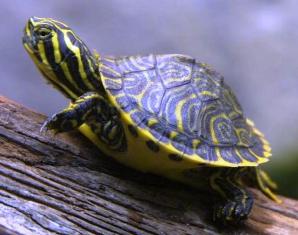Discover Florida Nature
It's time to explore the natural Florida


|
|
|
|
|
 Suwannee
Cooter -The Suwannee Cooter is found in drainage areas of
rivers that feed into the Gulf of Mexico from Hillsborough to Gulf
County in Florida. The Suwannee Cooter adapts readily to changes in
water salinity. The cooters shell has yellow markings that appear to be
spirals at a short distance. The Suwannee Cooter also has yellow stripes
on its head and front feet. This turtle reaches a maximum length of 16
inches. Often basking above the water on logs or snags, the Suwannee
Cooter has traditionally been collected for food, which has greatly
reduced its numbers. The Suwannee Cooter leaves its water habitat only
to nest during the summer. Suwannee
Cooter -The Suwannee Cooter is found in drainage areas of
rivers that feed into the Gulf of Mexico from Hillsborough to Gulf
County in Florida. The Suwannee Cooter adapts readily to changes in
water salinity. The cooters shell has yellow markings that appear to be
spirals at a short distance. The Suwannee Cooter also has yellow stripes
on its head and front feet. This turtle reaches a maximum length of 16
inches. Often basking above the water on logs or snags, the Suwannee
Cooter has traditionally been collected for food, which has greatly
reduced its numbers. The Suwannee Cooter leaves its water habitat only
to nest during the summer.  Spiny
Softshell Turtle- The Spiny Softshell Turtle gets its name from
the small spines on the edge of its shell, directly behind its neck.
This turtle is is found west of the Appalachicola and St. Mary's Rivers
in Florida. Softshell turtles are also called pancake turtles because of
their flat round shape. Their shells are soft enough to be a bit
flexible at the edges and are covered with a leathery skin. Sometimes
the shell is so soft that the shape of the underlying bone structure is
partially visible. Softshell turtles are highly aquatic, swift in the
water, and although they do bask on the shore, they usually stay close
enough to the water to make a fast underwater escape if danger
threatens. Spiny
Softshell Turtle- The Spiny Softshell Turtle gets its name from
the small spines on the edge of its shell, directly behind its neck.
This turtle is is found west of the Appalachicola and St. Mary's Rivers
in Florida. Softshell turtles are also called pancake turtles because of
their flat round shape. Their shells are soft enough to be a bit
flexible at the edges and are covered with a leathery skin. Sometimes
the shell is so soft that the shape of the underlying bone structure is
partially visible. Softshell turtles are highly aquatic, swift in the
water, and although they do bask on the shore, they usually stay close
enough to the water to make a fast underwater escape if danger
threatens. Yellow
Bellied Slider Turtle- The yellow bellied slider is a very
attractive turtle that was originally native to North Florida, but is
now often found in the southern part of the peninsula, where its numbers
seem to be increasing. It's rough carapace, or upper shell is marked
with prominent yellow bars on each side, and has a yellow patch behind
each eye. This sliders belly is usually bright yellow and always has
black blotches on the first pair of scales. The slider grows to a size
of about 11 inches. Yellow
Bellied Slider Turtle- The yellow bellied slider is a very
attractive turtle that was originally native to North Florida, but is
now often found in the southern part of the peninsula, where its numbers
seem to be increasing. It's rough carapace, or upper shell is marked
with prominent yellow bars on each side, and has a yellow patch behind
each eye. This sliders belly is usually bright yellow and always has
black blotches on the first pair of scales. The slider grows to a size
of about 11 inches. |
|
|
Advertise | Privacy Statement | Dog Encyclopedia | Video |Contact | Alaska Nature |
|